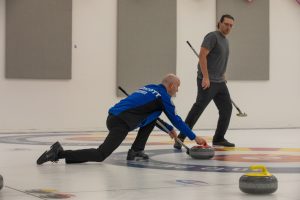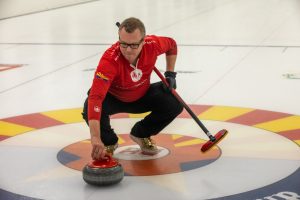- Slug: Sports-Curling in Arizona, 734 words.
- 2 photos available
By Gabrielle Ducharme
Cronkite News
TEMPE – Curling in Arizona feels like an oxymoron.
It takes place on a sheet of ice, with competitors pushing brooms, and is historically viewed as a sport most often played in Canada, not in the desert. The Valley, with its triple-digit temperatures, hardly seems a perfect match.
But Michael Siggins, Erik Kowal and Bob Leclair of Coyotes Curling Club in Tempe, who make up Team Siggins, are unbothered. They quietly worked toward an Olympic dream.
The three became friends through the Coyotes Curling Club over the last decade. Siggins and Kowal became teammates, and Leclaire their coach, after watching the 2018 Winter Olympics in PyeongChang. All are from different walks of life, states, even countries, but they are bonded in their passion for the sport.
Leclair grew up in Canada and moved throughout the country for most of his adult life. He recently retired from working with Kellogg’s and decided he would relocate to Arizona to partake in his two favorite things: curling and golf.
“First people I will call each place if I go back to visit,” Leclaire said. “Whether it’s Ontario, Manitoba, Saskatchewan, I will call the curlers that I played with.”
The same goes for Siggins, the team captain, who owns Pasta Brioni in Old Town Scottsdale. After battling through what he calls a “chaotic” year and a half because of the pandemic, the one constant became his curling community.
“We actually had an employee pass away from COVID,” Siggins said. “I went from working 80 hours a week in my two restaurants, to paying my staff to not work, closing one down, pulling my daughter from daycare and spending every single day with her.”
Kowal, who works at an Aerospace engineering manufacturing company, knows the sacrifices of training on an Olympic level, while also having a full-time job.
Mix in the pandemic, and it’s a wonder some athletes even bother to compete. For Team Siggins, the fault in the sporting world’s universe meant a chance to qualify for the 2022 United States Olympic Trials.
When COVID-19 struck in March 2020, Coyotes Curling, like everywhere else in the world, shut down. So too did the Curling world rankings. When the rankings unfroze in 2021, Team Siggins got the call that it had qualified for an Olympic Trials pre-tournament.
“We’re the first to win a national championship (in Arizona),” Kowal said, referring to the team winning 2019 Club Nationals. “We’re the first (to go) to an Olympic Trials series, so hopefully down the road, as the sport continues to grow here in Arizona, we’ll be able to … continue off our success.”
In early September, Team Siggins competed at the Olympic Trials Qualifying Series in Seattle. They failed to advance any further in the series, but still celebrated “the Spirit of Curling” the only way they knew how: Team Dunnam took Team Siggins out for dinner and drinks. Curling athletes do this frequently and discuss the match, their fellow competitors and lives outside the sport.
Training for an Olympic trials is a feat few will ever experience. But finding the time and money to train when all team members work full-time jobs, and have little to no sponsorship, is difficult. When Team Siggins received word they qualified, Leclaire had to remind the athletes that sometimes blessings come from the strangest of places.
“I talked the other guys into going because experience is something you want to get once in every four years,” Leclaire said. “Who knows how long you’re going to have that opportunity.”
Just one week after the pre-trials competition, the Coyotes Curling Club was filled with people ready to train, including Siggins, Leclaire and Kowal. It’s filled with fathers running late to pick up their daughters from dance class because practice ran long. It’s filled with people cracking jokes about how to describe the sport of curling to others.
“It’s a combination of shuffleboard and chess on ice,” Kowal said. “Shuffleboard is the most relatable game to it. You slide a puck down on a shuffleboard table, just like you’d slide a curling rock down a sheet of ice.”
It’s filled with 40 pound “stones” banging against each other, and brooms lined up in racks, like hockey sticks. It’s filled with people like Kowal, Siggins and Leclaire who feel right at home on the ice, especially in Arizona.
“I’ll competitively curl until they drag me off the ice,” Leclaire said.
For more stories from Cronkite News, visit cronkitenews.azpbs.org.

